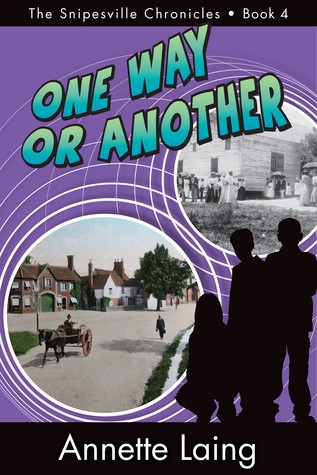
One Way or Another, (The Snipesville Chronicles, Book 4) by Annette Laing, (2017, 443 pages), which Laing describes as “crossover MG/YA”, is a time travel story unique for its ambitious reach re settings, characters, and issues, especially the forthright exploration of race issues. First, the Goodreads summary:
Hannah, Brandon, and Alex are survivors. What started for them as a boring year in the small Southern town of Snipesville has turned into months of unpredictable and dangerous time travel. And no matter where (or when) their adventures take the three, they are always drawn back to Balesworth, a little town in England. But why?
When Hannah’s long-anticipated reunion with a Balesworth friend goes badly wrong, she finds herself in 1905 England, facing her toughest challenge yet: Persuading a privileged but wayward teen to reform. But how privileged or wayward is she? Brandon and Alex, meanwhile, are a year ahead of Hannah, in the sinister Snipesville of 1906, as the clock ticks down to the day in the town’s history that is destined to be called We Don’t Talk About That.
One Way or Another, Brandon, Hannah, and Alex bring The Snipesville Chronicles series to its startling conclusion, as they uncover the secrets of Snipesville, and of their extraordinary lives.
Author Interview

Dr. Annette Laing
TTx2: One Way or Another was the last book in a series that spanned ten years. Besides providing an ending, did you want to accomplish anything different in this book than in the previous three?
I wanted to persuade every last reader to like Hannah! Writing a deliberately complicated anti-heroine, while silently listening to the complaints of my adult readers that she “didn’t learn her lesson” was hard. I hope they get it now, because it was always my goal to win them round. I did drop hints early in the series that Hannah was difficult by design. The attitude that had got her into trouble in 1940s England in Don’t Know Where, Don’t Know When (Book 1) gave her resilience in A Different Day A Different Destiny (Book 2), as she endured horrendous conditions in Victorian Scotland. And It would have made no sense if Hannah had suddenly become conformist, both because her tricky character was important to the humor of my stories, and because among my points is that young people seldom conform to society’s expectations. Nor should they.
In One Way or Another, I also really wanted to compel my white readers to see the past through the eyes of a black character, Brandon specifically. Race is a theme in all the novels, but in One Way or Another, I was finishing the manuscript at the height of the Black Lives Matter movement, and I pushed the envelope. My perspective has always been what academics are now calling intersectionality, which in real English means the ways in which class, gender, and race must be considered together to understand the past and present. Now, I am curious to see if the Trump presidency will make my work more relevant to readers, or whether Snipesville will become a museum piece. Obviously, I hope the former, and not just for the sake of my books.
TTx2: I liked the contrast between the settings in this book of Balesworth, England in 1905, and Snipesville, Georgia, 1906. You were able to have your characters travel to some other times and places in books one through three. How much of an outline for the entire series did you have before you started writing the first book? At what point in writing your series did you decide that in the last book the characters would go to 1905/1906?
I started the first book with a lovely outline. It soon went out of the window. That’s because Mrs. Devenish suddenly morphed into someone who demanded a central role. She ended up the most popular character of the series, and so I decided early on that I would bring her back in One Way or Another. Does that count as a plan?
Maybe it’s because I’m a historian, used to adjusting my thesis when the evidence overwhelms it, but I can’t imagine having worked from a rigid outline for the series. That said, I always knew that the second book would be set in the mid-19th century (so I could write about slavery, the industrial revolution, and all those batty mid-Victorians). I knew Book 3 would send the characters to an obscure corner of colonial America (I’m an early Americanist, plus I like messing with people’s textbook understandings of American history).
But my original intention was that there would be five books, and that the last two would be set around 1906 and in 1951. Unfortunately, the hints I had to drop about the conclusion, so I could defend myself against charges of a deus ex machina finale, were too much. They led a few beta readers of Book 3 to guess the ending, and although I fixed that, I decided I couldn’t sustain the suspense through two more books. This however explains the length of One Way or Another. Ahem.
TTx2: What was the hardest part about writing the series? What was the hardest part about writing this last book in particular?
I loved writing Snipesville, and so the hardest part of writing the series was letting go of it. That’s a smug answer, isn’t it?
So the second hardest thing was finding time to write it, since much of my time is taken up with presenting in schools.
Still a lame answer. Maybe the best response I can offer is that I worked really hard not to make the series formulaic. How’s that?
Moving on….
One Way or Another was inevitably the toughest of the four to write, because it was the last, but also because I had to inflict the early 20th century South on the lovely Brandon. I wept with him at the psychological brutality of segregation, and because he and I both know that the rural South is still a troubled and troubling place more than a century later. The racism is more subtle today, but it’s still overwhelming, not least because it is often so subtle, and it pervades everything. The ending of the book is optimistic, but against all odds. And that’s the hardest thing of all, wondering if anything I write makes the slightest difference to how people think. Readers have kindly told me that it does, and I do hope they’re not just being polite.
TTx2: If you could time travel anywhere and hang out there for a couple of weeks, where/when would you go?
I wish this was more creative, but it’s true: I would go to Britain in the early sixties, when I was born. I want to see that lost world as an adult.
My Review
I love that Dr. Laing didn’t write this book for everyone. If she had, it would be shorter with bigger margins. If she had, she might not have tackled issues of racism head-on, for fear of offending someone. We might not have been treated to characters debating at such length the kind of change to advocate for in regards to the early 1900’s issues of suffrage for women and equal rights for African-Americans–incremental change or immediate full equality? But I am so glad she wrote the book her way. And while I usually prefer shorter books, I make an exception for this one. 🙂
Laing really created two worlds in this story, one of class-segregated 1905 England, and the other of race-segregated 1906 Georgia. Each one was full of fascinating details, obviously the result of extensive research or knowledge on the part of the author. I was pained to read of how extensively segregation constricted the lives of African-Americans in the early 1900’s. I learned more about the legal discrimination against African-Americans that existed for so long in this country. In addition, Laing depicted examples of daily social rules that favored whites. She also highlighted some overarching forces that constrained African-Americans–for example the fact that if they were too successful in running their businesses whites might resent them or even violently attack them.
The other world, that of maids and their employers in early 1900’s England, was a world I knew next to nothing about before reading this book. It was interesting to read about how social rules that separated rich and poor affected so many aspects of life. For example, it was considered improper for maids to enter a house through the same door as non-maids. While the merits of the approaches of Booker T. Washington vs. that of W.E.B. Du Bois were compared in the section about Georgia, in the section about England, Hannah and the teen in the family that employs her as a maid debate the tactics of suffragists such as Emmeline Pankhurst who did not shy away from destroying property vs. suffragists who wanted to proceed more politely.
The author takes the time to develop the characters and they are eminently likeable. It takes commitment to read a hefty book like this. Most of those willing to invest the time will find it worthwhile.
Kirkus Review of One Way or Another.
For more middle grade book reviews, follow the links on Shannon Messenger’s blog.


I haven’t read a Snipesville Chronicle in a while and will definitely have to seek out this one. I always enjoy them. Thanks for your review and especially your author interview.
Thanks for the insightful interview. The author didn’t just give a pat answer to your questions. I’d like to read the book myself, but the length might scare away a few young readers.
I hadn’t read any of the Snipesville books. I can see that I need to do that. I loved the interview. Very insightful. Thanks for this great review.
I have got to pick up this series. I can’t believe I haven’t heard of it til now. Thanks. At least it will occupy my time until Timeless season 2!
Wow, this sounds like a unique series packed with little-known historical facts! I haven’t heard of the Snipesville books before. I enjoyed the interview with Annette, as it gave me so much insight into her writing. I’ll have to check out the series. Thank you for introducing us to Annette!
Pingback: 46 Time Travel Book Series for Kids |